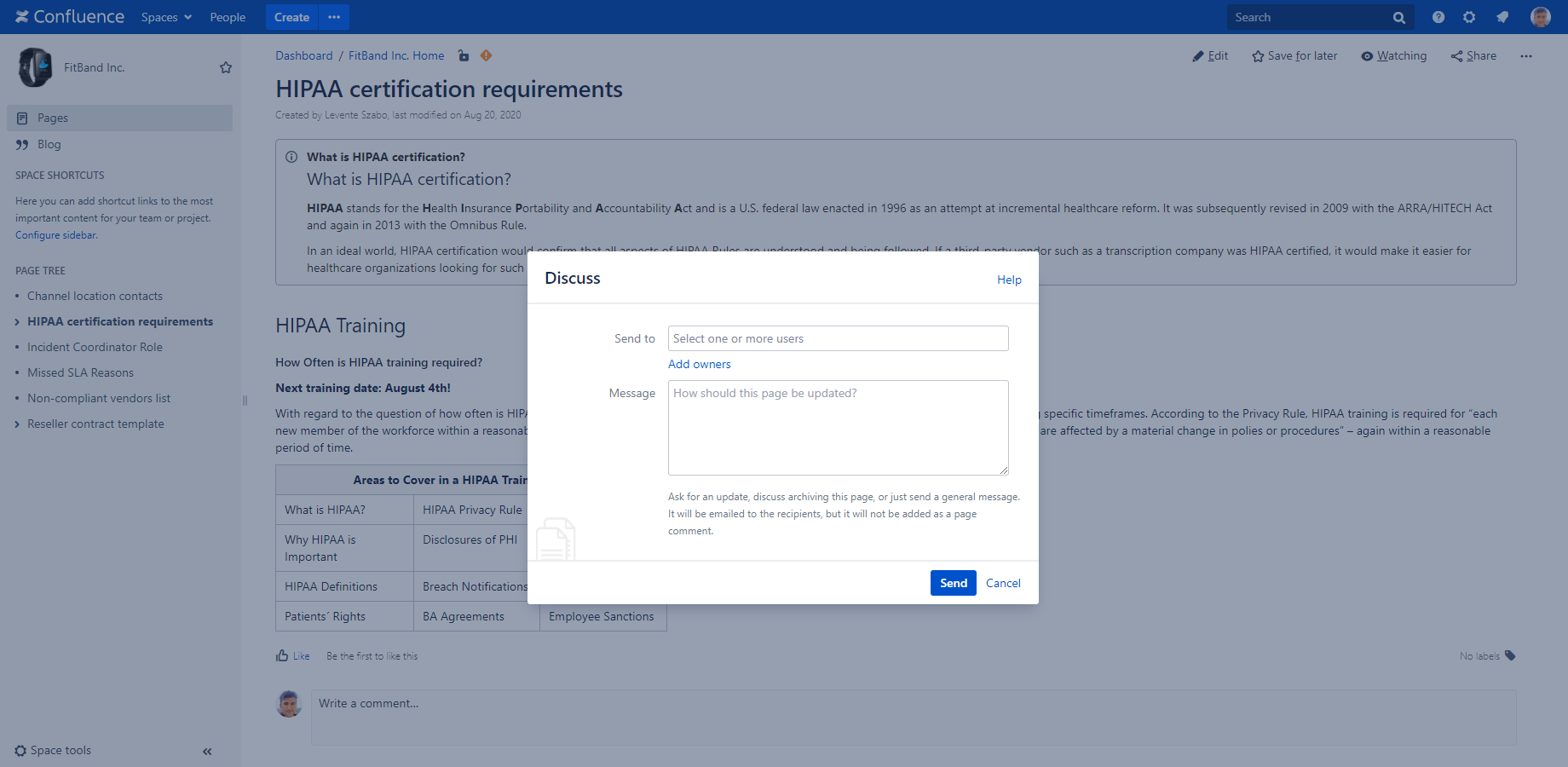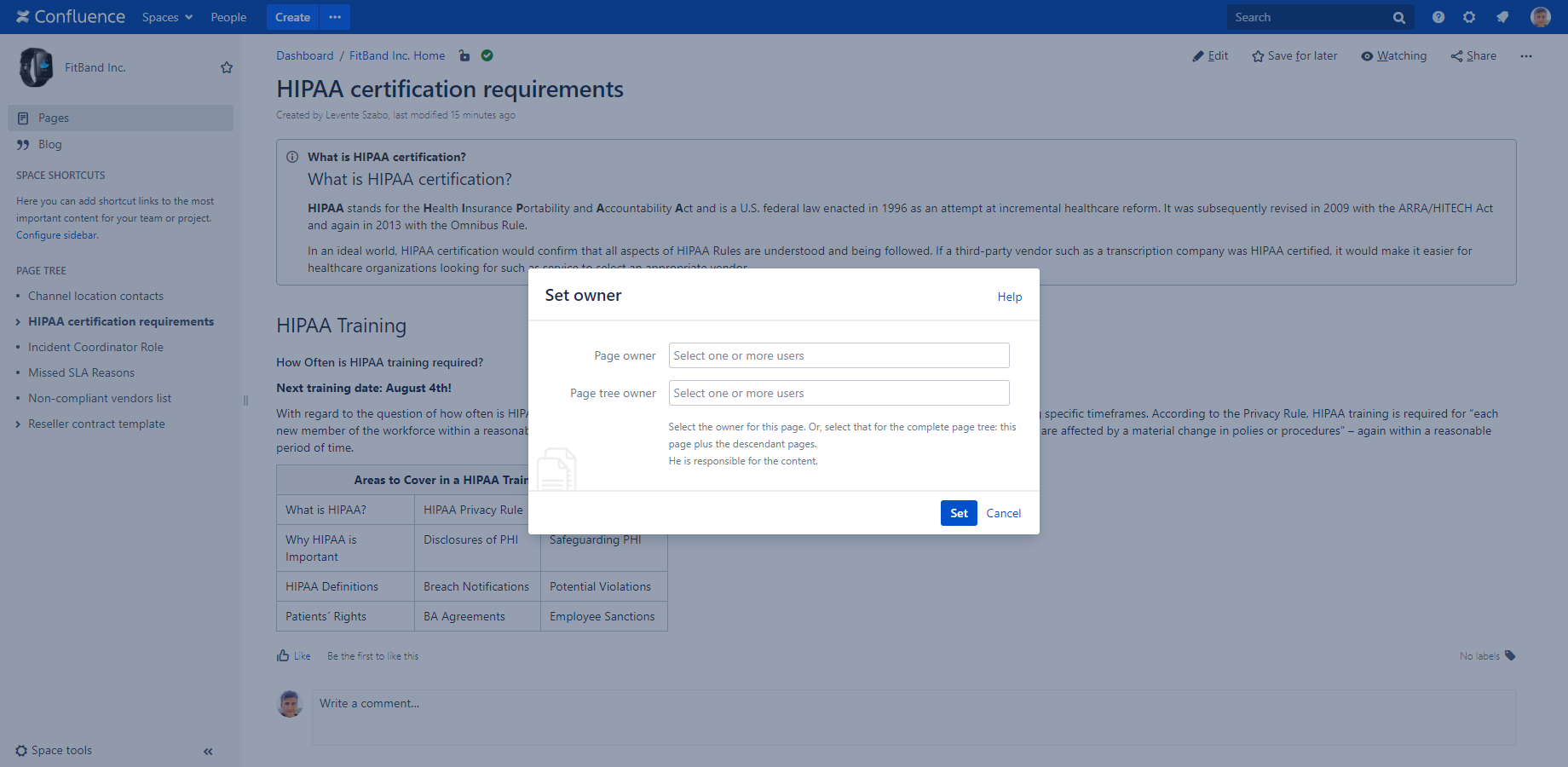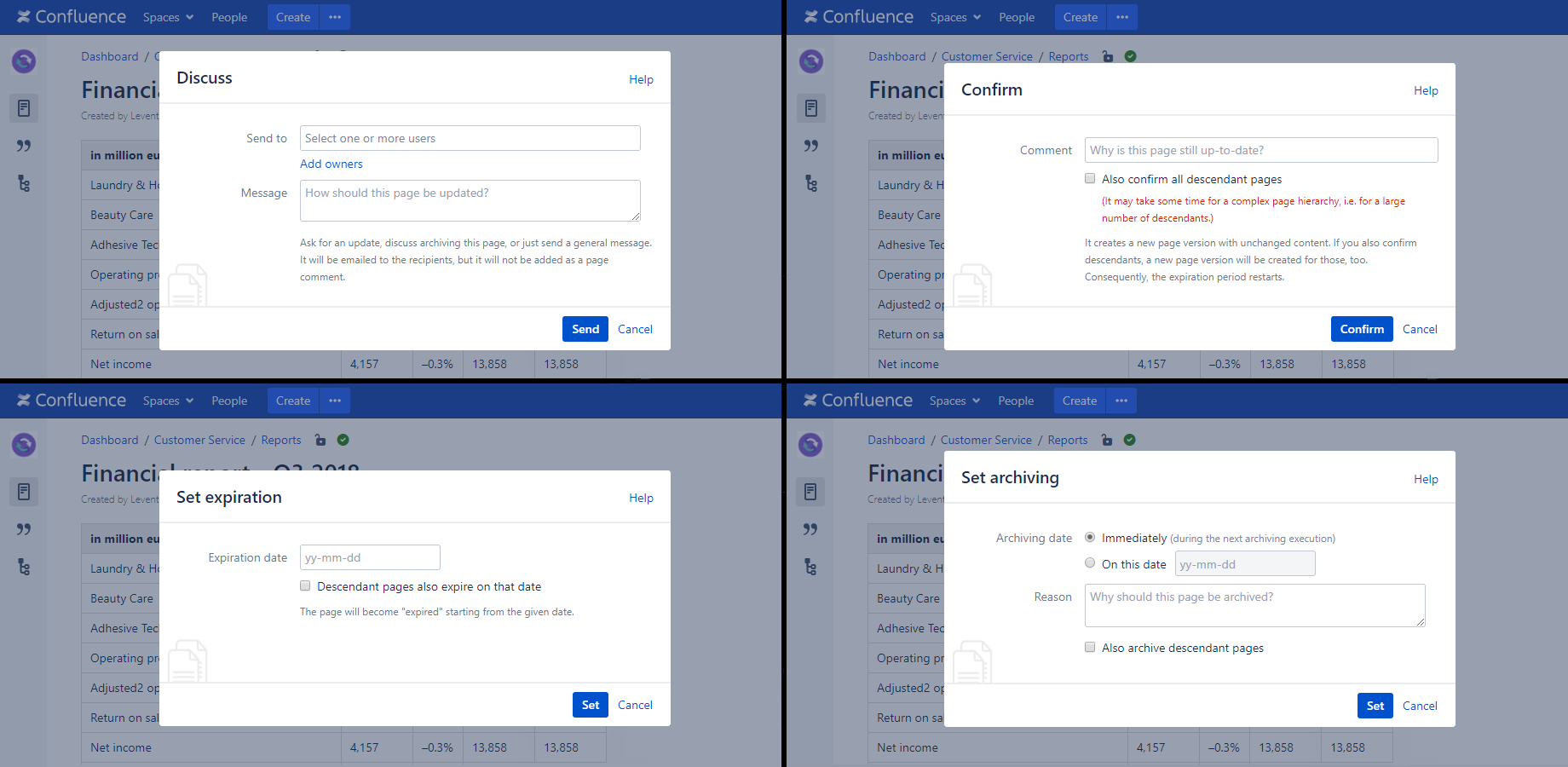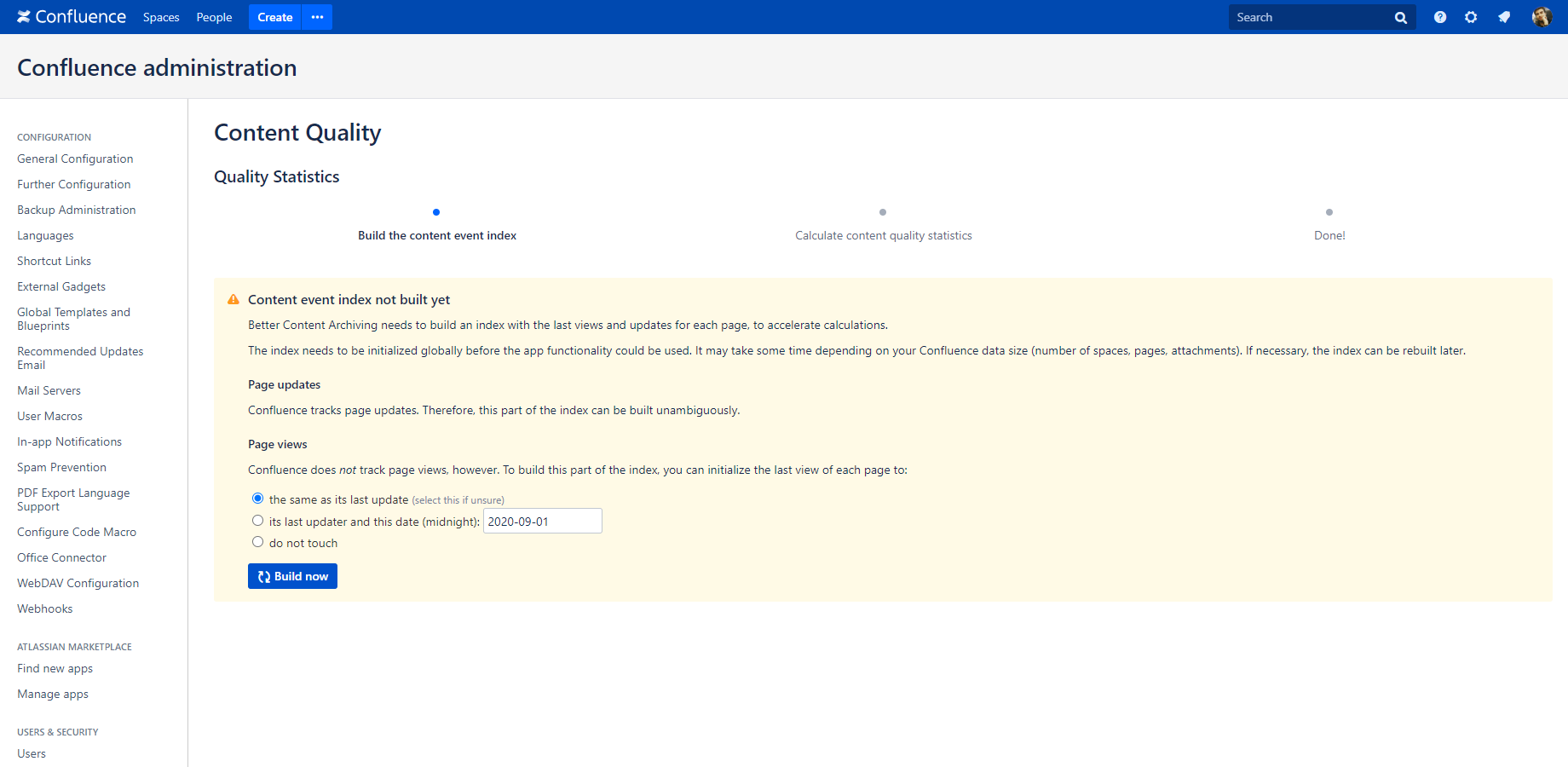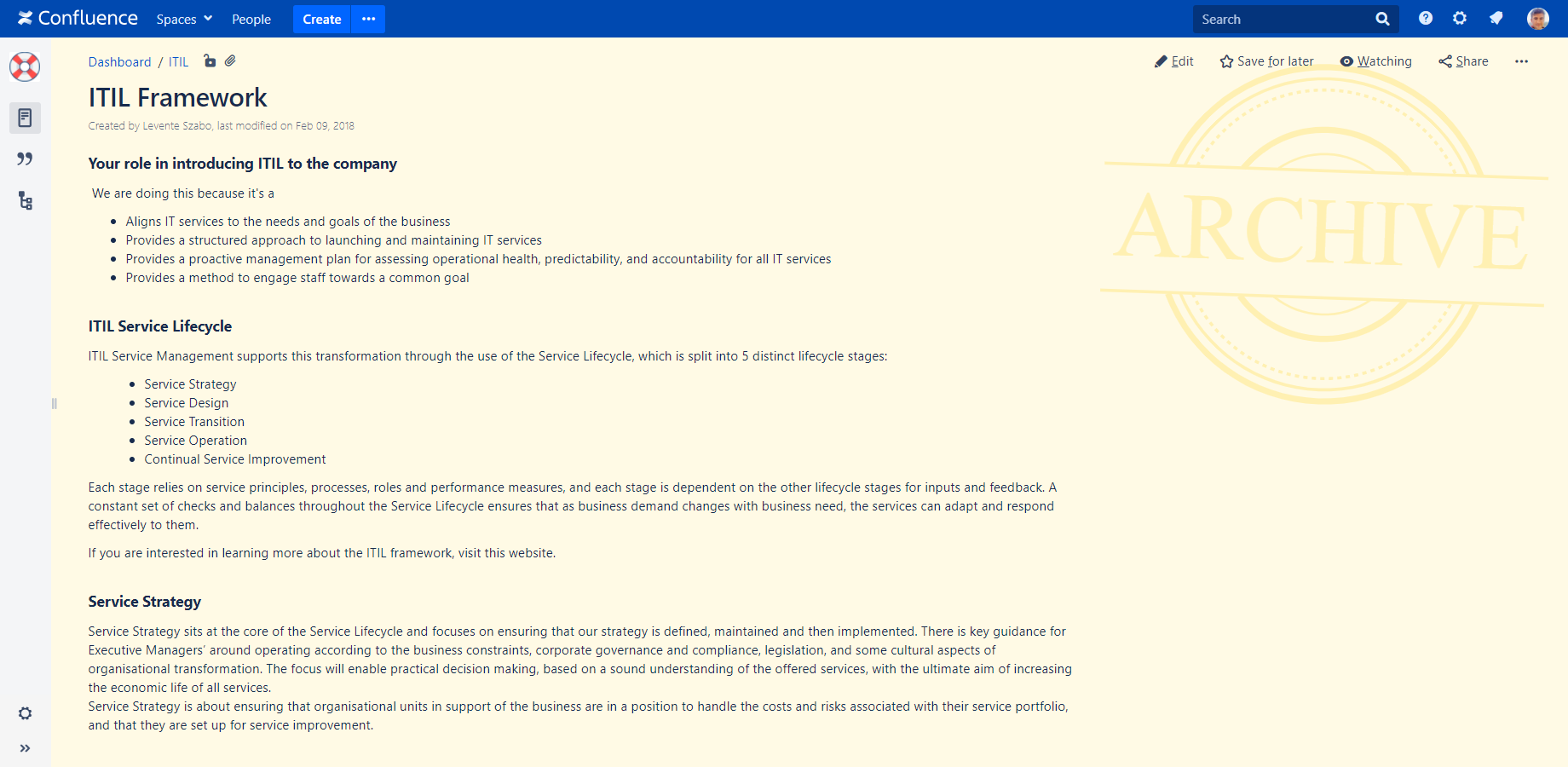In this page
Release notes
9.5.0
Faster Global Configurations screen
Upgrading from 9.4.0
9.4.0
Confluence 8.8 compatibility
Upgrading from 9.3.0
9.3.0
Faster Content Quality screen
Improvements
Upgrading from 9.2.0
9.2.0
Improvements
Upgrading from 9.1.0
9.1.0
"Discuss" quick action improvements
Java 17 support
Security fixes
Bugfixes
Upgrading from 9.0.0
9.0.0
Confluence 8.0 compatibility
Upgrading from 8.12.0
8.12.0
Upgrading from 8.11.0
8.11.0
Upgrading from 8.10.0
8.10.0
Upgrading from 8.9.0
8.9.0
Upgrading from 8.8.0
8.8.0
Content owners
Notable changes
Bugfixes
Upgrading from 8.7.0
8.7.0
Upgrading from 8.6.0
8.6.0
What feature is disabled in 8.6.0?
Upgrading from 8.5.0
8.5.0
Support for Confluence read-only mode
Upgrading from 8.4.1
8.4.1
Bugfixes
Upgrading from 8.4.0
8.4.0
Confluence 7.0 compatibility
Bugfixes
Upgrading from 8.3.0
8.3.0
Quick actions
Improvements
Upgrading from 8.2.0
8.2.0
Default archiving configuration
Trusted group
Improvements
Bugfixes
Upgrading from 8.1.0
8.1.0
Bye-bye "Archiving Plugin for Confluence"! Hello "Better Content Archiving for Confluence"!
Data privacy (for GDPR)
Upgrading from 8.0.0
8.0.0
Archiving Plugin is a Data Center approved app!
Upgrading from 7.5.0
7.5.0
Upgrading from 7.4.0
7.4.0
Page view initialization
Adding missing page views when updating existing installations to 7.4.0
Multiple supervisors per archiving configuration
Improvements
Upgrading from 7.3.0
7.3.0
Upgrading from 7.2.0
7.2.0
Distinct style for archive spaces
Intelligent label filtering
Improvements
Bugfixes
Upgrading from 7.1.0
7.1.0
Upgrading from 7.0.1
7.0.1
Bugfixes
Upgrading from 7.0.0
7.0.0
Support for Confluence Data Center (cluster)
Sharing data in a cluster
Executing long-running tasks in a cluster
Compatibility with Confluence 6.2
Known issues reported to Atlassian
Upgrading from 6.1.2
Version history
| Version | Date | Notes | ||
|---|---|---|---|---|
| 9.5.0 | 10/04/2024 | Faster Global Configurations screen. | Release Notes & Upgrade Guide | Download |
| 9.4.0 | 14/03/2024 | Compatibility release for Confluence 8.8. | Release Notes & Upgrade Guide | Download |
| 9.3.0 | 27/02/2024 | Faster Content Quality screen. | Release Notes & Upgrade Guide | Download |
| 9.2.0 | 26/04/2023 | Preparation for Confluence Server end-of-support. (Last release for Confluence Server!) | Release Notes & Upgrade Guide | Download |
| 9.1.0 | 16/02/2023 | "Discuss" quick action improvements. Java 17 support. | Release Notes & Upgrade Guide | Download |
| 9.0.0 | 23/01/2023 | Compatibility release for Confluence 8.0. | Release Notes & Upgrade Guide | Download |
| 8.12.0 | 03/11/2021 | Compatibility release for Confluence 7.14. | Release Notes & Upgrade Guide | Download |
| 8.11.0 | 24/08/2021 | Compatibility release for Confluence 7.13. | Release Notes & Upgrade Guide | Download |
| 8.10.0 | 23/04/2021 | Compatibility release for Confluence 7.12. | Release Notes & Upgrade Guide | Download |
| 8.9.0 | 29/08/2020 | Compatibility release for Confluence 7.7. | Release Notes & Upgrade Guide | Download |
| 8.8.0 | 27/08/2020 | Content owners. | Release Notes & Upgrade Guide | Download |
| 8.7.0 | 06/07/2020 | Compatibility release for Confluence 7.6. | Release Notes & Upgrade Guide | Download |
| 8.6.0 | 04/06/2020 | Compatibility release for Confluence 7.5. | Release Notes & Upgrade Guide | Download |
| 8.5.0 | 29/11/2019 | Support for Confluence read-only mode. | Release Notes & Upgrade Guide | Download |
| 8.4.1 | 08/10/2019 | Maintenance release. | Release Notes & Upgrade Guide | Download |
| 8.4.0 | 07/10/2019 | Compatibility release for Confluence 7.0. | Release Notes & Upgrade Guide | Download |
| 8.3.0 | 24/07/2019 | Quick actions. | Release Notes & Upgrade Guide | Download |
| 8.2.0 | 30/05/2019 | Default archiving configuration. Trusted group. | Release Notes & Upgrade Guide | Download |
| 8.1.0 | 28/09/2018 | Data privacy (for GDPR). | Release Notes & Upgrade Guide | Download |
| 8.0.0 | 31/08/2018 | Support for the new Data Center Approved Apps program. | Release Notes & Upgrade Guide | Download |
| 7.5.0 | 27/06/2018 | Compatibility release for Confluence 6.10. | Release Notes & Upgrade Guide | Download |
| 7.4.0 | 06/02/2018 | Page view initialization. Multiple supervisors. | Release Notes & Upgrade Guide | Download |
| 7.3.0 | 31/01/2018 | Compatibility release for Confluence 6.7. | Release Notes & Upgrade Guide | Download |
| 7.2.0 | 16/10/2017 | Distinct style for archive spaces. Intelligent label filtering. Various useful improvements. | Release Notes & Upgrade Guide | Download |
| 7.1.0 | 09/09/2017 | Compatibility release for Confluence 6.4. | Release Notes & Upgrade Guide | Download |
| 7.0.1 | 29/05/2017 | Maintenance release ("Data integrity error in migrated archiving configuration") | Release Notes & Upgrade Guide | Download |
| 7.0.0 | 24/05/2017 | Support for Confluence Data Center. Compatibility release for Confluence 6.2. | Release Notes & Upgrade Guide | Download |
Release notes
9.5.0
This version comes with another major performance improvement.
Faster Global Configurations screen
This performance improvement is rather similar to the performance improvement of the "Content Quality" screen we released in app version 9.3.0. This time we converted another screen, "Global Configurations", to use the same modern API that we utilized for "Content Quality" in 9.3.0.
With the optimization we managed to achieve 10-50 times faster loading of "Global Configurations", depending on the size of the Confluence instance!
Notes:
- If you had no visible performance problems with "Global configurations" before, it may not bring any improvement to you.
- If you experience any problem while loading the "Global configurations" screen, just downgrade to the previous app version (trivial and safe!) and report the problem to us.
Upgrading from 9.4.0
Just update your app version using UPM (Universal Plugin Manager, the app manager built in to Confluence).
9.4.0
This version is a compatibility release for Confluence 8.8.
Confluence 8.8 compatibility
With Confluence 8.8, Atlassian has started to prepare the upcoming Data Center Platform 7, by introducing certain internal changes. This app release is compatible with all these early changes, although there are no changes in terms of app features.
Upgrading from 9.3.0
Just update your app version using UPM (Universal Plugin Manager, the app manager built in to Confluence).
9.3.0
This version comes with a major performance improvement.
Faster Content Quality screen
A few of our enterprise customers running very large Confluence instances reported that loading the Content Quality screen and the Content Quality Statistics themselves took several minutes on their instances. We identified that the bottleneck is loading their large number of actively tracked spaces.
In this version we rebuilt the corresponding logic on the top of a new, more modern Confluence API. As result, the screen may now be loading up to 10 times faster depending on the instance.
Notes:
- If you had no visible performance problems with "Content Quality" before, it may not bring any improvement to you.
- As the Confluence API now used by the app is available only from Confluence 7.x versions, starting from this app version Confluence 6.x is not supported anymore.
- If you experience any problem while loading the "Content Quality" screen, just downgrade to the previous app version (trivial and safe!) and report the problem to us.
Improvements
- URLs in the app-written log entries are updated to point to the documentation of the app's Data Center version.
Upgrading from 9.2.0
Just update your app version using UPM (Universal Plugin Manager, the app manager built in to Confluence).
9.2.0
This version introduces a few changes as a preparation for the Confluence Server end-of-support. This is our last release for Confluence Server!
Important: don't forget that Confluence Server will be retired in February 2024!
Improvements
- On Confluence Server, a new message box informs administrators about the availability of the app's Cloud and Data Center versions.
- All URLs are updated to point to the documentation of the app's Data Center version.
Upgrading from 9.1.0
Just update your app version using UPM (Universal Plugin Manager, the app manager built in to Confluence).
9.1.0
This version introduces improvements on the "discuss" quick action, Java 17 support and various fixes.
"Discuss" quick action improvements
The "discuss" quick action was improved with three valuable additions.
These improvements make the action more powerful especially in case of multi-user discussions:
- The new link "Add owners" will add the content owners to the "Send to" field with one click. As content owners are frequently involved in review discussions or in making decisions about the content's lifecycle (should this be updated? should this be archived? etc.), this little utility is a significant time-saver.
- The "discuss" notification email now shows the users that participate in the discussion. Each recipient will see who else was invited to the discussion. (You can customize its appearance or even remove it from the email template using the $replyToUsers Velocity context object.)
- Now, when someone replies to an email sent by this quick action using "Reply All" in the email client, all original recipients will receive the reply. Unlike the built-in "Share page" feature, which is essentially a one-time one-direction message, "discuss" now allows continuous group email conversations about the page!
Learn more about the discuss quick action.
Java 17 support
Java 17 LTS is the latest long-term support release for the Java SE platform. Since Confluence 8.0.0, it is a platform supported by Confluence.
This app version is the first one which supports both Java 11 and 17. From now, Midori is committed to maintain the compatibility with both.
Security fixes
The internal versions of the following dependencies were updated:
- Moment.js
We strongly suggest upgrading to this app version as soon as possible!
Bugfixes
- Fixed: When a space is totally empty (contains zero pages), its content quality becomes 50% unexpectedly.
- Fixed: The "Trusted group" selector doesn't contain any option in its drop-down, unless there are at least 3 characters entered.
Upgrading from 9.0.0
First, update your app using UPM (the app manager built in to Confluence).
To support the "discuss" quick action improvements in the notification emails, a new Velocity context object $replyToUsers was introduced. Therefore, the default notification email templates were updated in this app version. If you haven't customized the notification email templates (i.e. if you are using the defaults), then there is nothing else to do.
If you have made changes to those (adding instructions in the top is a very typical customization, for example), then you will need to migrate those customizations to the new templates.
Steps:
- Copy the content of your current email template to a textfile old.txt. (It's a good idea to save it somewhere as a backup.)
- Click Reset default under the email template. It will reset it to the new default (without your customizations).
- Copy the content of this new default email template to another textfile new.txt.
- Compare old.txt and new.txt, and merge all changes you made in the former to the latter. Use a visual merge tool (like WinMerge), and it will be trivial.
- Copy the merged result back to Confluence and save it.
- Repeat these steps for every notification template that you have customized.
9.0.0
This version is a compatibility release for Confluence 8.0.
Confluence 8.0 compatibility
While there are no changes in terms of app features, lots of changes were made in the app's internals. Confluence 8.0 introduced API-breaking changes, upgraded critical dependencies and removed deprecated code. This app release is compatible with all those, plus it maintains compatibility back to Confluence 5!
Upgrading from 8.12.0
Just update your app version using UPM (Universal Plugin Manager, the app manager built in to Confluence).
8.12.0
This version is a compatibility release for Confluence 7.14.
Upgrading from 8.11.0
Just update your app version using UPM (Universal Plugin Manager, the app manager built in to Confluence).
8.11.0
This version is a compatibility release for Confluence 7.13.
Upgrading from 8.10.0
Just update your app version using UPM (Universal Plugin Manager, the app manager built in to Confluence).
8.10.0
This version is a compatibility release for Confluence 7.12.
Upgrading from 8.9.0
Just update your app version using UPM (Universal Plugin Manager, the app manager built in to Confluence).
8.9.0
This version is a compatibility release for Confluence 7.7.
Upgrading from 8.8.0
Just update your app version using UPM (Universal Plugin Manager, the app manager built in to Confluence).
8.8.0
This version introduces the concept of content owners.
Note that "custom page owners" (the original name of this feature) was the second most popular feature request in our public feature request tracker. As end-user needs are the most important driver for the product roadmap, we strongly encourage you to visit the existing feature requests, cast your vote and write your use case in a comment!
(Insider info: the currently most popular feature request is coming soon, too!)
Content owners
Content owners are one or more manually selected users who are responsible for the content in a single page or in a whole page tree.
Content owners can optionally be notified when the page becomes not-viewed, expired or archived. The concept is similar to, for example, the author or the last modifier of the page, but while these are "implicit" roles (determined automatically), page owners are "explicit" (selected manually).
You may have noticed that we call them "content owners", not "page owners". We use the more general term, because they are responsible also for the attachments of the page, and also because in a future app version this feature will be extended to blog posts, as well.
Learn more about content owners.
Notable changes
In the next few releases, we will make the terminology more consistent throughout the app user interface and the documentation. We will use more precise terms and less synonyms. Note that these are changes only in the wording, the underlying features are not changed unless otherwise mentioned in the release notes.
In this version, we introduce the following changes:
- Terminology change: "archiving job" is now called "content lifecycle job".
- Terminology change: "archiving event" is now called "content audit log event", while "content events" (as a screen title) becomes "content audit log".
Bugfixes
- Fixed: when collapsing the node of a last sibling in the Content Status Browser, sometimes all nodes "below it" disappear from the UI.
Upgrading from 8.7.0
First, update your app using UPM (the app manager built in to Confluence).
Then, review your existing lifecycle configurations and consider turning on the "Notify owners" settings. When you create a new lifecycle configuration, the default settings described in the table below will be used, but for existing lifecycle configurations all those three will be set to "Off" at the version upgrade. This is because we want to avoid unexpected behavior caused by the silent configuration change. If you want to use the content owners feature with existing configurations (you should!), edit the existing configurations and turn on the "Notify owners" settings according to your needs.
| Default "Notify owners" setting | |
|---|---|
| Page view tracking | On |
| Page expiration tracking | On |
| Page archiving | Off |
To support the content owners feature, the new archiving reason "You're receiving this email because you're an owner" was added to the notification emails. Therefore, the default notification email templates were updated in this app version. If you haven't customized the notification email templates (i.e. if you are using the defaults), then there is nothing else to do.
If you have made changes to those (adding instructions in the top is a very typical customization, for example), then you will need to migrate those customizations to the new templates.
Steps:
- Copy the content of your current email template to a textfile old.txt. (It's a good idea to save it somewhere as a backup.)
- Click Reset default under the email template. It will reset it to the new default (without your customizations).
- Copy the content of this new default email template to another textfile new.txt.
- Compare old.txt and new.txt, and merge all changes you made in the former to the latter. Use a visual merge tool (like WinMerge), and it will be trivial.
- Copy the merged result back to Confluence and save it.
- Repeat these steps for every notification template that you have customized.
8.7.0
This version is a compatibility release for Confluence 7.6.
Atlassian has fixed the bug that was introduced in Confluence 7.5.0 and made us to disable the "hide archive space" feature in the previous version of Better Content Archiving for Confluence. In this release we re-enabled that feature.
IMPORTANT: If you are using Confluence 7.5.0 or 7.5.1, don't forget to upgrade your Confluence version to 7.5.2 or newer (otherwise the app won't function correctly due to the above mentioned bug)!
Upgrading from 8.6.0
Just update your app version using UPM (Universal Plugin Manager, the app manager built in to Confluence).
8.6.0
Recently released Confluence 7.5.0 introduced a bug around archiving spaces. The bug broke the "create archive space" mechanism in the Better Content Archiving app.
While we work with Atlassian on the bugfix, this temporary app version helps you to upgrade to Confluence 7.5.0. It disables only a fairly minor app feature that's affected by the bug, but even that feature can be worked around manually.
As soon as the bug is fixed by Atlassian, we will release another app version that re-enables the feature.
What feature is disabled in 8.6.0?
It doesn't matter if you checked setting the archive space's status to "Archived" in an archiving configuration, it will not work. Consequently, all newly created archive spaces will have the "Current" status. (Existing archive spaces are not affected, they remain in "Archived" status.)
This is somewhat misleading, but other than the side-effects below, it is harmless:
- Your users may receive duplicated search results: one from the fresh and the other from the archive space.
- Your users may see the pages that are located in the archive space in activity streams.
- Your users may "get lost" while navigating: they will see both the fresh and the archive space, containing similar and overlapping content.
All other app features work correctly.
Super-easy manual workaround: after a new archive space was created by an archiving execution, set its space status to "Archived" manually. (Unless you create large number of new archive spaces, it is absolutely manageable.)
Upgrading from 8.5.0
Just update your app version using UPM (Universal Plugin Manager, the app manager built in to Confluence).
8.5.0
This version introduces compatibility with the so-called read-only mode in Confluence. As that feature is available only in Confluence Data Center, this particular app version does not introduce any new feature for Confluence Server users. (Even if so, Confluence Server users should upgrade to this version, too, because future versions will be built on the top of 8.5.0.)
Support for Confluence read-only mode
Read-only mode is a Confluence Data Center feature that helps performing maintenance tasks without stopping Confluence. Similarly to Confluence, the Better Content Archiving app also limits the app-provided actions the user can perform in read-only mode.
Learn more about the support for read-only mode.
Upgrading from 8.4.1
Just update your app version using UPM (Universal Plugin Manager, the app manager built in to Confluence).
8.4.1
This version comes with two less-critical bugfixes with which we didn't want to delay the previous version, 8.4.0, the compatibility release for Confluence 7.0. Now these are tested and released for the public.
Bugfixes
- Fixed: the "Trusted group" field in the "Settings" screen cannot be used with 30,000 groups.
- Fixed: when the secure administrator session times out, saving blacklisted spaces will reset that to an empty list.
Upgrading from 8.4.0
Just update your app version using UPM (Universal Plugin Manager, the app manager built in to Confluence).
8.4.0
Confluence 7.0 compatibility
This version is a compatibility release for Confluence 7.0.
It may sound like a relatively simple release, but it's most definitely not. Confluence 7.0, being a major release, introduced significant changes including API-breaking ones. This app release is compatible with those.
Bugfixes
- Fixed: the "Last Execution" column in the Scheduled Jobs screen is empty for 2 of the app's jobs.
Upgrading from 8.3.0
First, update your app using UPM (the app manager built in to Confluence).
Important: updating to this app version will reset the schedules of the app jobs to their defaults! It is because in this release the app was converted from using Quartz-managed jobs to using modern Caesium-managed jobs. As Caesium does not transparently pick up the custom schedules configured for Quartz, schedules will reset to their defaults.
At the same time, the new default schedules for the app jobs are the same as the old default schedules.
Consequently:
- If you have not changed the schedules of the app jobs, then there's nothing to do. (Jobs will be executed according to the default schedules, just like they did before the upgrade.)
-
If you have changed the schedules of the app jobs, then please re-apply those changes after upgrading.
See the Confluence documentation about changing a job's schedule.
It is simple and takes a minute.
(If you forget this, jobs will be executed according to the default schedules instead of your custom schedules after the upgrade.)
Since this is very unlikely that you changed the schedule of the 2 jobs named "Better Content Archiving: Persist the...", you should focus on these two jobs only:- "Better Content Archiving: Analyze Content Quality"
- "Better Content Archiving: Find and Archive Expired Content"
8.3.0
This release introduces "quick actions" which significantly ease controlling the lifecycle of pages. "Quick actions" is a concept that we have been experimenting with for a couple of months, and now release it for the public to elevate the end-user experience to a new level.
Quick actions
To ease working with the lifecycle of a page, the app now offers so-called quick actions. Using these you can work in a friendly, controlled and less error-prone way. Quick actions are available to discuss, update, confirm, expire and archive pages with ease.
Learn more about quick actions (don't forget to watch the short tutorial video!).
Improvements
- User manual section of the "Move" strategy is rewritten with more details on copying and synchronizing ancestor pages.
- New user manual section added about the permissions required to restore pages.
Upgrading from 8.2.0
First, update your app using UPM (the app manager built in to Confluence).
Quick actions were added to the notification emails so that users can easily take actions directly from the email context. Therefore, the default notification email templates were updated in this app version. If you haven't customized the notification email templates (i.e. if you are using the defaults), then there is nothing else to do.
If you have made changes to those (adding instructions in the top is a very typical customization, for example), then you will need to migrate those customizations to the new templates.
Steps:
- Copy the content of your current email template to a textfile old.txt. (It's a good idea to save it somewhere as a backup.)
- Click Reset default under the email template. It will reset it to the new default (without your customizations).
- Copy the content of this new default email template to another textfile new.txt.
- Compare old.txt and new.txt, and merge all changes you made in the former to the latter. Use a visual merge tool (like WinMerge), and it will be trivial.
- Copy the merged result back to Confluence and save it.
- Repeat these steps for every notification template that you have customized.
8.2.0
This release comes with two valuable features frequently requested by the user community. Although both of these are useful for smaller Confluence instances, too, they are super-important for administrators of Confluence sites with many spaces and many users. Thanks to Dorothee, Katharina, Justin, Marti, Rodrigo for helping us with their requirements' details!
Default archiving configuration
This new global setting allows selecting an archiving configuration which will be automatically applied to every new space, right after the creation of the space. It is a time-saver for Confluence instances where new spaces are created all the time, but content quality still must be under control.
Learn more about selecting the default archiving configuration.
Trusted group
This setting can restrict those space administrators who can configure and run archiving. It gives more safety if you have lots of space administrators who may not be familiar with the Better Content Archiving app.
Learn more about configuring the trusted group.
Improvements
- The "archive" watermark is visible in all spaces with the "archived" status (not only in the spaces created by the Better Content Archiving app).
- When creating archive spaces, anonymous and "all authenticated users" type permissions are not copied.
Bugfixes
- Fixed: by manually rewriting the space key from "Foo" to "FOO" in the URL, it is possible to set an archiving config to the same space multiple times (leading to confusing display of the association).
Upgrading from 8.1.0
Just update your app version using UPM (Universal Plugin Manager, the app manager built in to Confluence).
8.1.0
This release comes with a super-popular feature request implemented to protect personal information. Thanks to Enrico, Florian, Ganna, Karl, Katharina, Michael, Niko, Ralf for helping us with detailing their requirements!
Plus, most visibly, the app got a new name!
Bye-bye "Archiving Plugin for Confluence"! Hello "Better Content Archiving for Confluence"!
With this version we made a slight adjustment in the app's name, because the term "plugin" was replaced by Atlassian first with "add-on" and then with "app". We decided to completely remove this from the app's name.
You may still see the old name popping up here and there, until we roll out the change everywhere. Thanks for the patience!
Data privacy (for GDPR)
From this version, you can configure the visibility of the username of the last updater and last viewer. This feature was primarily requested by users in the EU region in order to protect personal information and comply with GDPR. We suggest reading our FAQ about data protection and GDPR in general.
This screenshot shows the configuration with the last viewer's identity hidden, but with the last updater shown:
It applies to all relevant screens in the Better Content Archiving app:
Learn more about configuring data privacy.
Upgrading from 8.0.0
Just update your app version using UPM (Universal Plugin Manager, the app manager built in to Confluence).
8.0.0
As you probably know, Archiving Plugin already supports Confluence Data Center deployments (i.e. clustered Confluence). To be precise, those are supported since app version 7.0.0 (released in May 2017).
In 2018, Atlassian re-launched its Data Center program and introduced new development and testing criteria for "Data Center approved apps". This version is the official release for the revised program, tested to live up to the rigorous demands of Data Center environments.
Archiving Plugin is a Data Center approved app!
The followings have been done to comply with the revised development and testing requirements:
- This version has been verified against the Atlassian's official Data Center technical checklist, which would identify potential non-cluster-safe parts in the app. All points are met.
- This version has been performance-tested with the official Atlassian Performance Testing Library. For your interest, we used AWS infrastructure and "c3.xlarge" type standard EC2 instances for hosting the Confluence nodes. The testing confirmed that the app works correctly and consistently in clusters with 1, 2, 4 and 8 nodes (and anything in-between).
- This version has been successfully tested with UPM 3.0, the new generation of the Universal Plugin Manager.
As a result, Archiving Plugin is a Data Center approved apps launch partner. The new program was announced at Atlassian Summit 2018 (3-5 September 2018, Barcelona).
Upgrading from 7.5.0
Just update your app version using UPM (Universal Plugin Manager, the app manager built in to Confluence).
7.5.0
This version is a compatibility release for Confluence 6.10.
Upgrading from 7.4.0
Just update your app version using UPM (Universal Plugin Manager, the app manager built in to Confluence).
7.4.0
Page view initialization
As you probably know, Confluence does not implement any sort of page view tracking. Because the workflows implemented by Archiving Plugin heavily rely on the last page view information, the app implements its own real-time page view tracking mechanism. Even with this mechanism in place, there was a limitation that confused many in the past. We call it the "abandoned pages" problem.
This version introduces a new feature to solve this problem. While this is still impossible to find out what happened before the app's installation (building a time machine is really hard! :-)), you can sensibly initialize the last page view information when building or re-building the content event index!
You can use the strategies that fits your users' expectations the best:
Learn more about page view initialization.
Adding missing page views when updating existing installations to 7.4.0
After updating the app version, we encourage you to re-build your global Content Event Index and add the last page view information for the pages without that. You can use one of the following strategies:
- Using the "the same as its last update" strategy: it sets the last view for abandoned pages the same as their last update. Please expect the consequences detailed in the next paragraph.
- Using the "its last updater and a specific date" option with the current date: it sets the last view to today. It is the safest option with no immediate consequences. If the abandoned pages are continue to stay non-viewed, they will be reported after the page view alert interval.
- Using the "its last updater and a specific date" option with a past date: by setting the last view to some user-given date it finds the abandoned pages faster. Please expect the consequences detailed in the next paragraph.
After you initialized the page view for abandoned pages (i.e. when all page has valid last view information), the app will start processing the pages it skipped previously. You can expect the following consequences:
- The "not-viewed pages" counts in Content Quality Statistics may increase (with the count of the abadoned pages added).
- The "not-viewed pages" lists in notification emails may be longer (with the abandoned pages added).
- Most importantly: if you are using the "not viewed for N days" trigger for page archiving, it may trigger archiving for abandoned pages!
If you are worried about these, try the page view initialization feature in a staging system (that has a copy of your production data) first.
Overall, as these abandoned pages will now be precisely tracked and reported, you can take actions to make your content leaner and its quality even better.
Multiple supervisors per archiving configuration
Starting from this version, you can select multiple users as supervisors in any archiving configuration. (In previous versions, you could select only one.) This allows making more than one person responsible for the space, resulting in even better content quality.
Improvements
- Content Quality Statistics and Start Archiving screens give a clear error message when long-running tasks cannot be started due to missing actors (i.e. when the "confluence-administrator" groups that contains the super-user does not exist or does not contain at least one valid user account).
- Archiving configuration editor gives more intuitive validation messages (related to the page view- and update intervals for various triggers).
- User interface improvements: the term "actor" is more consistently used, the "archive space's status" selector is more intuitively explained.
- Content improvements on the built-in Getting Started page.
Upgrading from 7.3.0
Just update your app version using UPM (Universal Plugin Manager, the app manager built in to Confluence). As a second step, add the missing page view information for the pages without that.
7.3.0
This version is a compatibility release for Confluence 6.7.
Upgrading from 7.2.0
Just update your app version using UPM (Universal Plugin Manager, the app manager built in to Confluence).
7.2.0
Distinct style for archive spaces
One of the user feedback we received time to time was that users unwantedly edited archive pages because they didn't realize that they are in an archive space's context. To address this, the app gives a clear, but non-obtrusive style to archive pages from this release. It includes a yellowish background color plus an expressive watermark. It is visible both on the wiki pages and in the space's administration screens to discourage "update" type operations.
Intelligent label filtering
Labels are used for various mechanisms in Confluence. From this version, when a page is moved or copied to the archive space, its labels are filtered to avoid unexpected behavior.
Improvements
-
Notification email templates have access to the archiving configuration to enable more informative notifications
- "Not-viewed pages" emails display the "page view alert limit"
- "Expired pages" emails display the "page expiration alert limit"
- The Customizing notification emails page in the documentation was rewritten for clarity and with more examples
Bugfixes
- Fixed: Inline comments become regular page comments in the archive space
- Fixed: Favorite pages are listed twice in the favorites list (once from the fresh space and once from the archive space)
- Fixed: Page renaming unexpectedly updates the last update date of the linked pages (by intercepting the events triggered by "LINK_REFACTORING")
- Fixed: Incomplete page and attachment data causes "Cannot set non-null field UPDATE_DATE to null" error while re-building the content update index
Upgrading from 7.1.0
Just update your app version using UPM (Universal Plugin Manager, the app manager built in to Confluence).
7.1.0
This version is a compatibility release for Confluence 6.4.
Upgrading from 7.0.1
Just update your app version using UPM (Universal Plugin Manager, the app manager built in to Confluence).
7.0.1
Bugfixes
- Fixed: "Data integrity error in migrated archiving configuration" error when upgrading to app version 7.0.0
Upgrading from 7.0.0
Just update your app version using UPM (Universal Plugin Manager, the app manager built in to Confluence).
7.0.0
Support for Confluence Data Center (cluster)
We are happy to announce that this app version implements the long awaited support for Confluence Data Center deployments!
Over the last 10 months we put insane efforts to the 6.x releases (the grounding work) and to this new release, aiming to provide Content Lifecycle Management for Confluence clusters. 6.x allows to efficiently process millions of pages, while 7.x allows to do that over multiple Confluence nodes.
The video below gives a short introduction to running the app on a cluster of 3 Confluence nodes. We first start the Calculate Quality Statistics task on node 1, then demonstrate that its progress can also be watched on node 2 and node 3. At completion, the result becomes visible on all nodes with no latency. Overall, the user experience is 99% identical with the single-server user experience!
Without going much into technical details, here is some high level information about how Archiving Plugin works in a cluster.
Sharing data in a cluster
All persistent Archiving Plugin data is managed using the ActiveObjects technology (by Atlassian). It guarantees that all database-persisted data and all changes are transparently replicated among the cluster nodes. Archiving configurations are an example of database-persisted data.
For non-persistent data that need to be shared among cluster nodes, Archiving Plugin uses cluster-wide caches relying on the Cache 2 technology (by Atlassian). It guarantees that all cached data are replicated among the cluster-nodes in nearly real-time. Long-running task state (progress) is an example of non-persistent data.
Executing long-running tasks in a cluster
The app's long-running tasks (like the Content Quality Calculation or the Content Archiving task) are executed only on one node in the cluster, generating load only on that single node! At completion, Archiving Plugin makes sure that the task results are replicated to all other nodes. For instance, the refreshed Content Quality Statistics are immediately visible on all nodes.
The task parallelization strategy is simple: at any time, there can be max one task being executed in the whole cluster. In other words, there is simply no parallelization. When a node wants to execute a task, it needs to acquire a cluster-wide lock and then release that at completion. Until that lock is available again, no other task can be started on any other node. The idea is to save the cluster from synchronization issues and from unnecessary load. As long-running tasks complete fast since the 6.0.x versions of the app, this simple and robust strategy will not be a limiting factor for through-put.
While the actual task is executed on a single node, other nodes allow tracking its progress using so-called proxy tasks. A proxy task on its own node appears like the actual task running on another node, displaying the message, the progress and the result of that. From the user point of view, proxy tasks make transparent whether the task is actually running on the node the user is connected to or on some other node.
All in all, the new era of highly-available Content Lifecycle Management has started. Happy clustering!
Compatibility with Confluence 6.2
This version is also a compatibility release for Confluence 6.2.
Known issues reported to Atlassian
There are two pending issues at the time of the release, that we reported for Atlassian. These are affecting the Archiving Plugin in some negative way, but cannot be fixed in the app side (at least the probability that these can be improved in our side are low).
Therefore we encourage you to step in, vote for these issues, add your details as a comment and watch the issue for potential updates. (Our hope is that the increased importance leads for faster results from Atlassian.)
- Mysterious "no row with the given identifier exists" errors when moving pages: CE-1044
- Page moves are significantly slower (although stable!) in newer Confluence versions than in Confluence 5.7: CE-1045
Upgrading from 6.1.2
Just update your app version using UPM (Universal Plugin Manager, the app manager built in to Confluence). Please note that after the upgrade you will have to recalculate the content quality statistics, because from this version those are now stored in a new "cluster-ready" database table.


